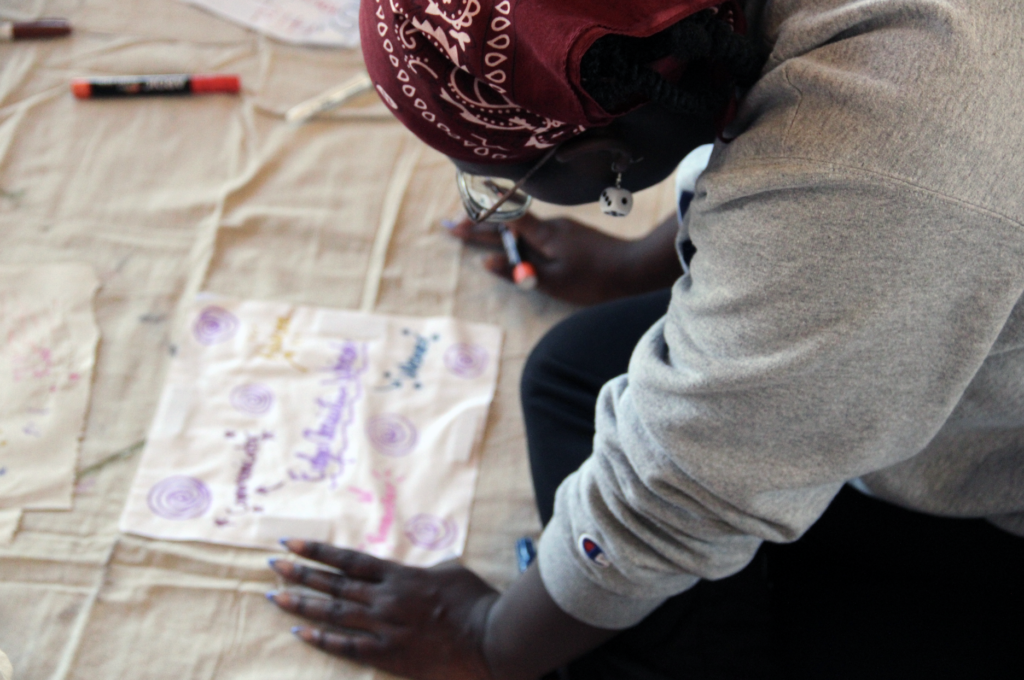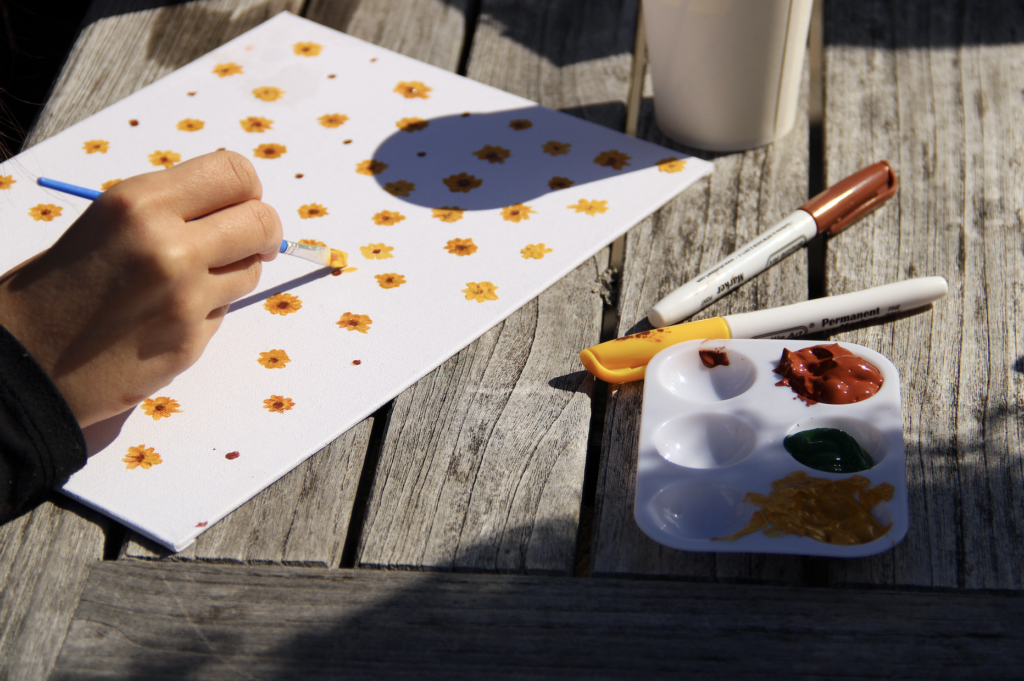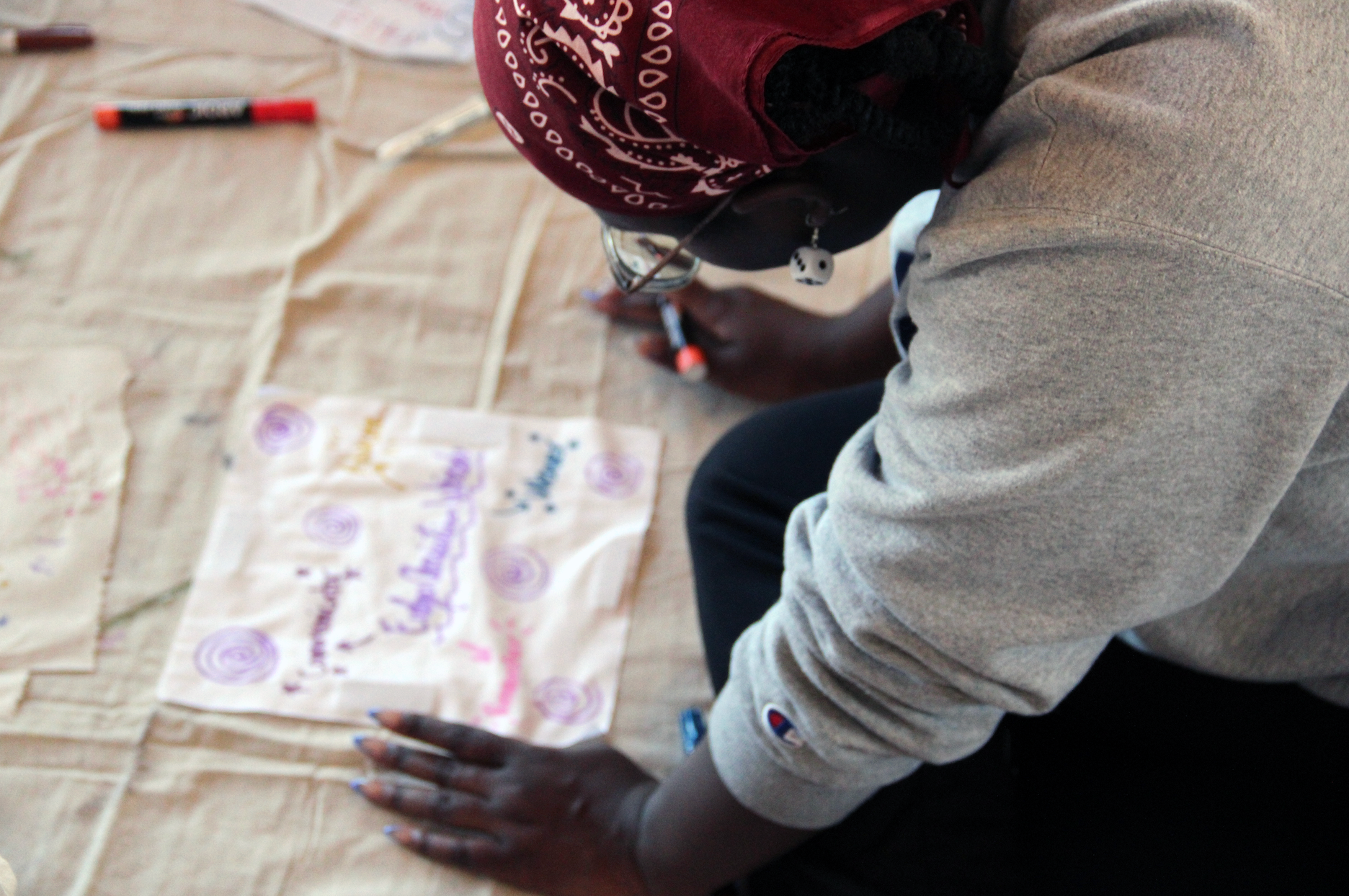A Reflection on Grounding: A New Retreat for BIPOC Students, Art, and Caring for our Common Home
By Sophia Monsalvo, COL ‘26, Environment and Sustainability

Someone making art during the Grounding Retreat. Photo courtesy of Sophia Rose Monsalvo.
Soil
In 2021, Georgetown University added “Care for Our Common Home” to the set of values of the “Spirit of Georgetown.” Grounding is the latest newcomer in the list of initiatives connected to the new value. What is Grounding? Grounding is a retreat and community for students of color to connect with their ancestry and the environment through art.
My name is Sophia Monsalvo and I am the creator of the Grounding Retreat. I am an artist and an environmental activist at Georgetown. I was inspired to start Grounding by an accident during my freshman year that changed my physical body, my life and my perception of my relationship with the natural world. Specifically, I began to wonder what it means to call some things natural and others not. I thought about the perceived physical and spiritual separation from our environment that so many of us exist in daily.
I reflected on my own ancestral and cultural community and saw how deep the legacies of this separation run. Enslavement, forced displacement, migration, genocide, and exploited labor have left imprints on the eyes, ears, and hands of these communities and many more across this campus and the globe. Everywhere I go, I see the destruction and mutilation of our world and the control and domination that plague our detachment from the life around us. In the balance of creation and destruction, so much had been ravaged and barely any planted. The powerful have extracted every possible resource, poisoned nearly all of the water, claimed every inch of land, and stolen every home of any human and animal who could not pay in their currency.
What has been given back to this land, to the water, the air, the animals? What has been given back to the people who built their empires? We can see that the balance is off. I can feel it in the staggered sway of my hips. Then, I could feel in my bones, that as broken as I was, so was our earth and society. Now, I can feel the grief in my body when I see what we have done to our home. The scars on my body reflect the scars on this land.
I tend to think of myself two-fold now, the body I lived in before my accident and the one I inhabit now. One of the things that has stayed with me in this new form is my need for creation. When I was younger, I was drawn to art as a method of controlling my reality. If I could bring something from the figurative idea to this physical world then I was not truly alone. After the accident, when I could not walk, run, or even stand up unsupported, I reached for a brush or a pen, to write, draw, and paint what I could not express with my voice or body. This is where I found the healing and creative essence of art. Art allowed me to depict the experiences as my heart felt them and not as my head knew them.
Roots
Through all of my physical and spiritual changes, I realized that I was making a mistake in trying to walk alone in my healing journey. I thought about the pain that I was experiencing; if we were all connected and intertwined in our journeys, then someone else was feeling what I was. I began to long for community and a space to connect ancestral, personal and environmental healing.
After speaking with people around campus and attending the Cookout and Escape retreats, I fell in love with the format of retreats to engage students outside of campus. With the rapid, work-driven and often toxic social culture at Georgetown, I wanted to create a space for students of color across cultures to engage with each other in the community and experience art as an act of healing and creation.
Why aim specifically at students of color? In my experience, environmentally focused spaces on campus are overwhelmingly white. The connections and interactions with the environment within my community were extremely different from what I saw within white environmental spaces. These spaces felt designed for the consumption or recreational appreciation of the natural environment. It did not feel like a homecoming. It felt like everything was in the mind, to study, observe and understand. Nothing felt like it was in the heart. I see the land, water, trees and animals as my elders. I look to understand their processes to understand my own. I feel my connection to them beyond this physical body. The environmental community I long for is focused on the heart and the spirit, not the head.
As a descendant of people who were enslaved on this country’s occupied land, I often struggle to relate to white environmental themes that do not share my legacy. The environment is connected to so many systems of oppression: food, water, air, transportation and labor. In this country, people of color have not been permitted to connect with the environment in the same way as white people. This is embodied in the fact that, at its founding, in our country only white people could own, cultivate and legitimize land.
The accessibility of green spaces is limited by money, time, physical accessibility and, even, awareness. This is why the retreat was created specifically for students of color: its intention is to identify, reflect and begin to reconcile the legacies of trauma we inherit in relation to our environment. In a space secluded from white supremacy–the Grounding Retreat–those of us who have been marginalized can center ourselves and from there begin to understand our relationship to the environment.
Grounding was designed to be a transformational experience in a 3-3-3 format, focusing on ancestry, art, and the environment in our familial, personal, and community relationships as we experience our past, present, and future. I designed three modules to take us through this journey: 1) History and Identity, 2) Healing and Reconciliation, and 3) Preparing for the Present. Each module featured a visual arts activity, speeches from a community leader and a reflective prompt. The retreat also featured an Interfaith Service led by Reverend Ebony Grisom that engaged the modules through the lens of the Laudato Si, reflection and connection to beings higher than ourselves.
Bloom
Upon embarking on this journey, the retreat was far more magical than I could have ever dreamed. Sitting in a circle with hearts poured, fingers covered in paint, and spirits filled with love, we shared space and represented ourselves in ways spoken and unspoken. We laughed, cried, ran in the sun, painted and rested.
In all of my planning, I did not realize just how much I needed the space that I co-created at Grounding. What Georgetown is teaching me most of all is that if I do not have a space that I need, I can create it because someone else probably needs it too.
As I imagine the legacy of Grounding, I imagine my vision for our world. Coming of age as an adult in this time of history is, honestly, terrifying. As a queer, Colombian and African-American woman at this university choosing to devote my life to environmental activism, I learn more each day that the road ahead is not an easy one. But through Grounding, I’ve realized that it is not something that I have to walk alone. None of us have to walk alone.

Someone painting flowers on a table outside during the Grounding Retreat. Photo courtesy of Sophia Rose Monsalvo.
Seeds
The journey ahead of us to adapt our lives and societies to climate change will be unlike anything we have seen before. We all must reconcile with the legacies we hold, the relationships we have with ourselves and the interactions we have with the environment all around us. Always, we must connect with each other and the life around us in ways we have never imagined. We must be creative, understanding, resilient, reflective, humble and loving. I ache with gratitude for the ability and privilege to facilitate this space and bring this idea to the world. I hope that Grounding continues to be a space of reconciliation, healing and community for students of color at Georgetown for years to come.
Grounding was born through a community of people that extends far beyond myself. My co-coordinator, Akil Cole, believed in the vision of this retreat from the first day. He has been my thought partner, confidant, liaison and friend. Reverend Ebony Grisom, director of Protestant Life in Campus Ministry, brought this idea to life within the Georgetown administration. We could not have done this without her trust, counsel and energy. We are also immensely grateful to the community leaders who shared their beautiful energy and space within the modules and activities, including Dr. Barwendé Sané, a post-doc fellow in the Environmental Justice Initiative, Ashanee Kottage, a post-Bacc fellow at the Earth Commons and the Laboratory for Global Performance & Politics, Dr. Melanie White in the Department of Black Studies and Alumni A. Prince Albert III, President and CEO of Goldwater Ventures.
Within each of the participants, student leaders, coordinator, faculty and community members, Grounding planted a seed that is now ours to grow, fruit, and plant again. It has been one of the greatest joys, accomplishments and journeys to have brought this experience to Georgetown.
I am so excited for how it will grow and mature just as I – and we all – do. From the soil to the roots to the bloom, the seeds return to the ground and we continue our journey.

